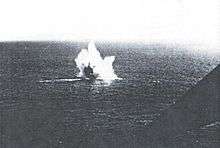German submarine U-128 (1941)
 Air attack on U-128 | |
| History | |
|---|---|
| Name: | U-128 |
| Ordered: | 7 August 1939 |
| Builder: | DeSchiMAG AG Weser in Bremen |
| Laid down: | 10 July 1940 |
| Launched: | 20 February 1941 |
| Commissioned: | 12 May 1941 by Ulrich Heyse |
| Fate: | Sunk, 17 May 1943 |
| General characteristics | |
| Class and type: | Type IXC submarine |
| Displacement: |
|
| Length: |
|
| Beam: |
|
| Height: | 9.60 m (31 ft 6 in) |
| Draught: | 4.70 m (15 ft 5 in) |
| Installed power: |
|
| Propulsion: |
|
| Range: |
|
| Test depth: | 230 m (750 ft) |
| Complement: | 4 officers, 44 enlisted |
| Armament: |
|
German submarine U-128 was a Type IXC U-boat of Nazi Germany's Kriegsmarine during World War II. She was sunk 17 May 1943, by American action.
Design
German Type IXC submarines were slightly larger than the original Type IXBs. U-128 had a displacement of 1,120 tonnes (1,100 long tons) when at the surface and 1,232 tonnes (1,213 long tons) while submerged.[1] The U-boat had a total length of 76.76 m (251 ft 10 in), a pressure hull length of 58.75 m (192 ft 9 in), a beam of 6.76 m (22 ft 2 in), a height of 9.60 m (31 ft 6 in), and a draught of 4.70 m (15 ft 5 in). The submarine was powered by two MAN M 9 V 40/46 supercharged four-stroke, nine-cylinder diesel engines producing a total of 4,400 metric horsepower (3,240 kW; 4,340 shp) for use while surfaced, two Siemens-Schuckert 2 GU 345/34 double-acting electric motors producing a total of 1,000 metric horsepower (740 kW; 990 shp) for use while submerged. She had two shafts and two 1.92 m (6 ft) propellers. The boat was capable of operating at depths of up to 230 metres (750 ft).[1]
The submarine had a maximum surface speed of 18.3 knots (33.9 km/h; 21.1 mph) and a maximum submerged speed of 7.3 knots (13.5 km/h; 8.4 mph).[1] When submerged, the boat could operate for 63 nautical miles (117 km; 72 mi) at 4 knots (7.4 km/h; 4.6 mph); when surfaced, she could travel 13,450 nautical miles (24,910 km; 15,480 mi) at 10 knots (19 km/h; 12 mph). U-128 was fitted with six 53.3 cm (21 in) torpedo tubes (four fitted at the bow and two at the stern), 22 torpedoes, one 10.5 cm (4.13 in) SK C/32 naval gun, 180 rounds, and a 3.7 cm (1.5 in) as well as a 2 cm (0.79 in) anti-aircraft gun. The boat had a complement of forty-eight.[1]
Service history
Ordered on 7 August 1939 from DeSchiMAG AG Weser in Bremen, U-128 was laid down on 10 July 1940, launched on 20 February 1941 and commissioned by Kapitänleutnant Ulrich Heyse on 12 May 1941.
The boat was a training vessel in the second flotilla until 30 November 1941 based in Wilhelmshaven. She was then based in Lorient.
During her six completed war patrols, U-128 sank 12 ships, for a total of 83,639 tons. On 1 March 1943 command was transferred to Kptlt. Hermann Steinert, who commanded her until her loss a few months later.
Fate
On 17 May 1943, while operating in the South Atlantic near Pernambuco, two Mariner flying boats, PBM 74-P5 and PBM-74-P6 of the US Navy Patrol Squadron VP-74, made U-128 surface with depth charges. Two US Navy destroyers (USS Jouett and Moffett) also hit her with 5-inch gunfire. The crew opened the submarine's seacocks as they abandoned ship, scuttling the submarine. The final toll was seven dead but there were 47 survivors.
Summary of raiding history
References
- 1 2 3 4 Gröner 1991, p. 68.
Bibliography
- Busch, Rainer; Röll, Hans-Joachim (1999). German U-boat commanders of World War II : a biographical dictionary. Translated by Brooks, Geoffrey. London, Annapolis, Md: Greenhill Books, Naval Institute Press. ISBN 1-55750-186-6.
- Busch, Rainer; Röll, Hans-Joachim (1999). Deutsche U-Boot-Verluste von September 1939 bis Mai 1945 [German U-boat losses from September 1939 to May 1945]. Der U-Boot-Krieg (in German). IV. Hamburg, Berlin, Bonn: Mittler. ISBN 3-8132-0514-2.
- Gröner, Erich; Jung, Dieter; Maass, Martin (1991). U-boats and Mine Warfare Vessels. German Warships 1815–1945. 2. Translated by Thomas, Keith; Magowan, Rachel. London: Conway Maritime Press. ISBN 0-85177-593-4.
External links
- Hofmann, Markus. "U 128". Deutsche U-Boote 1935-1945 - u-boot-archiv.de (in German). Retrieved 7 December 2014.
- Helgason, Guðmundur. "The Type IXC boat U-128". German U-boats of WWII - uboat.net. Retrieved 7 December 2014.
Coordinates: 10°00′00″N 35°34′59″W / 10.000°N 35.583°W